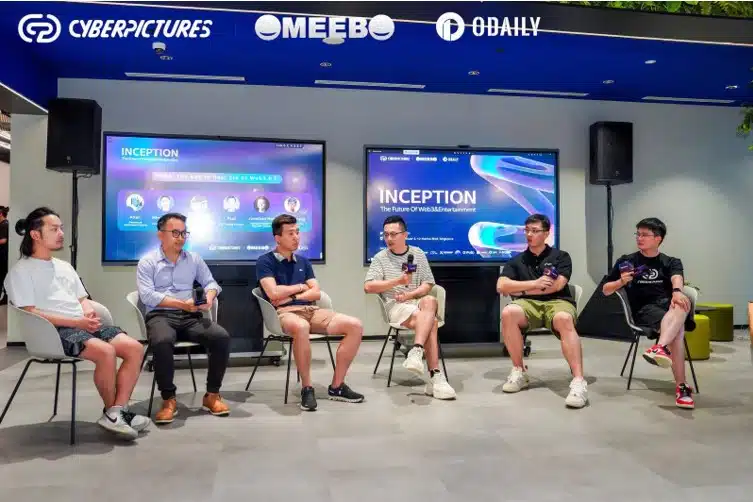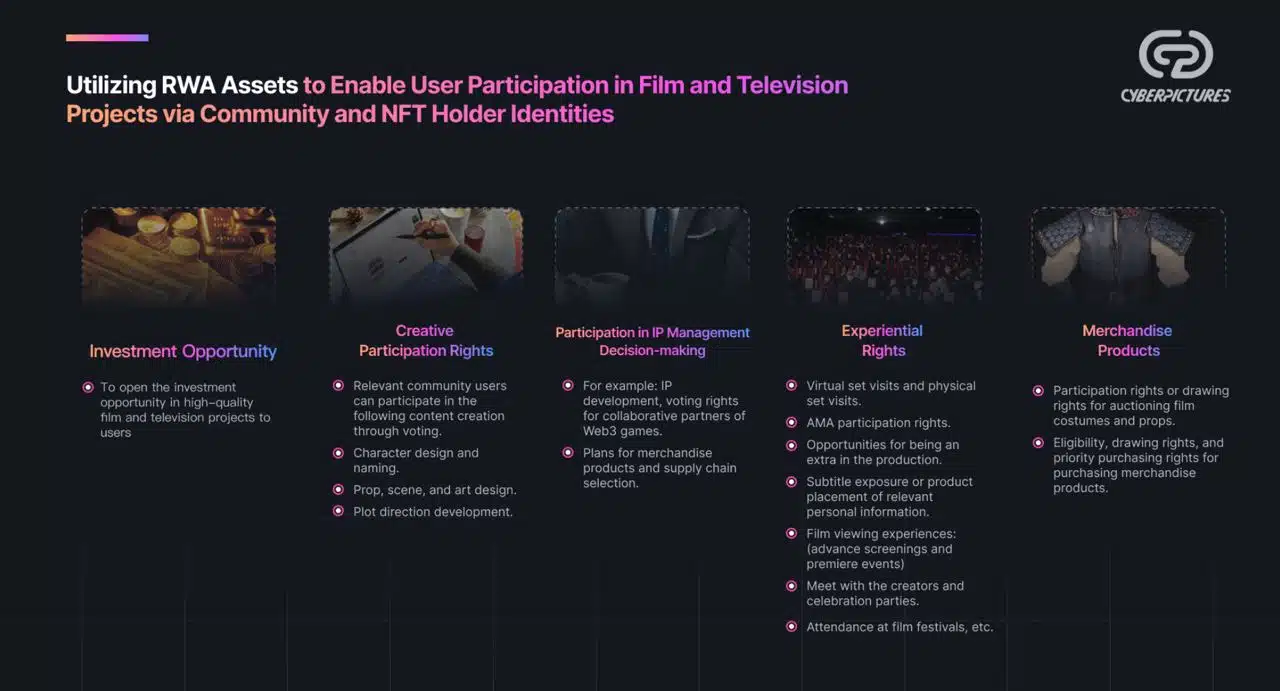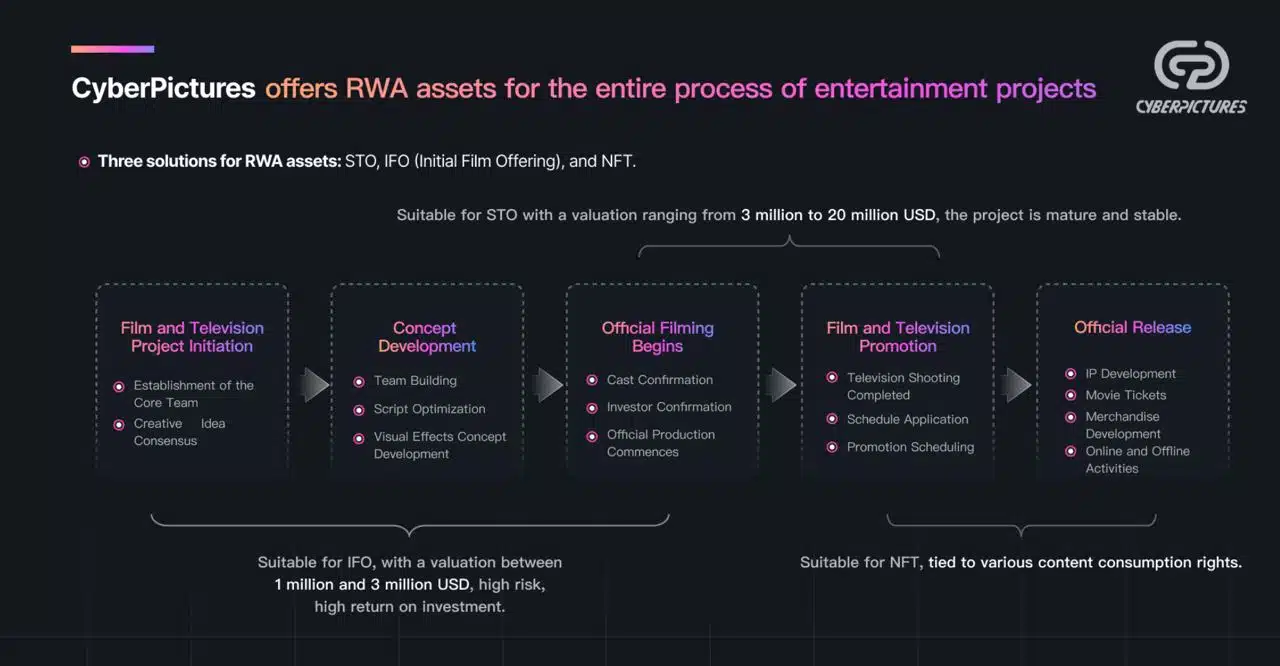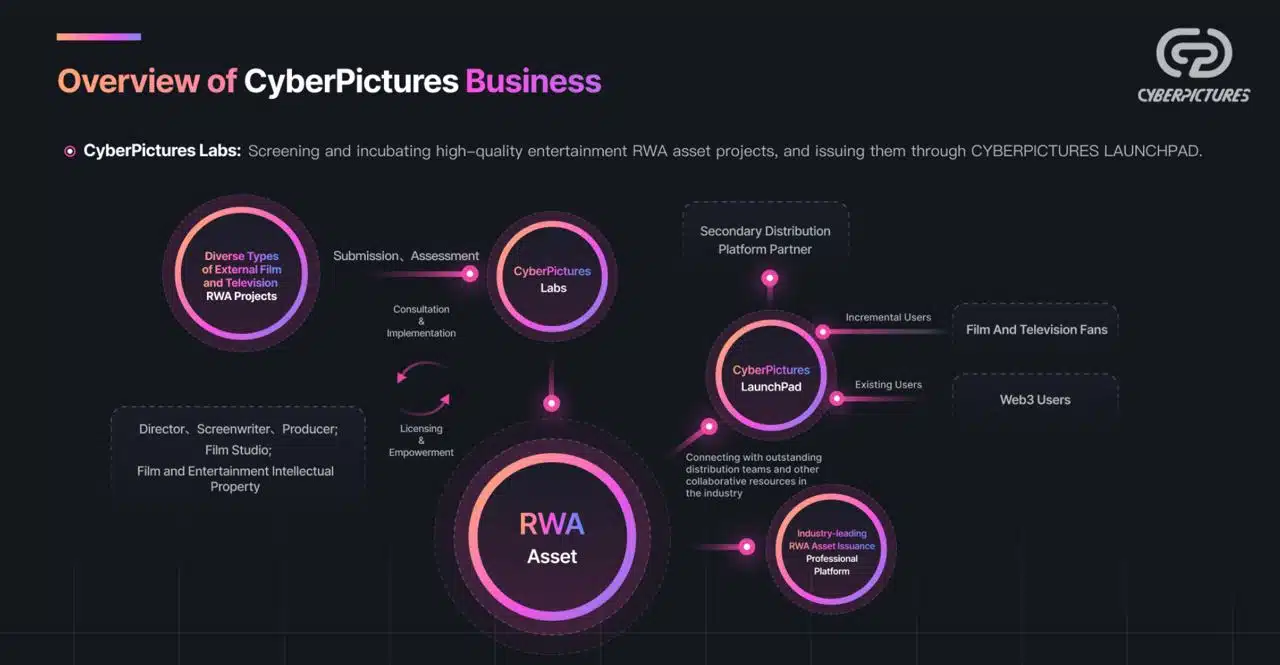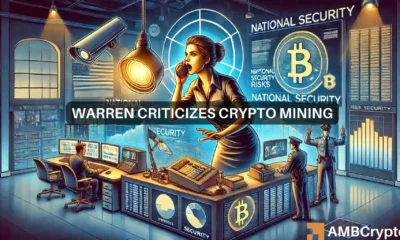CyberPictures: Bridging traditional film resources with high-quality RWA Assets
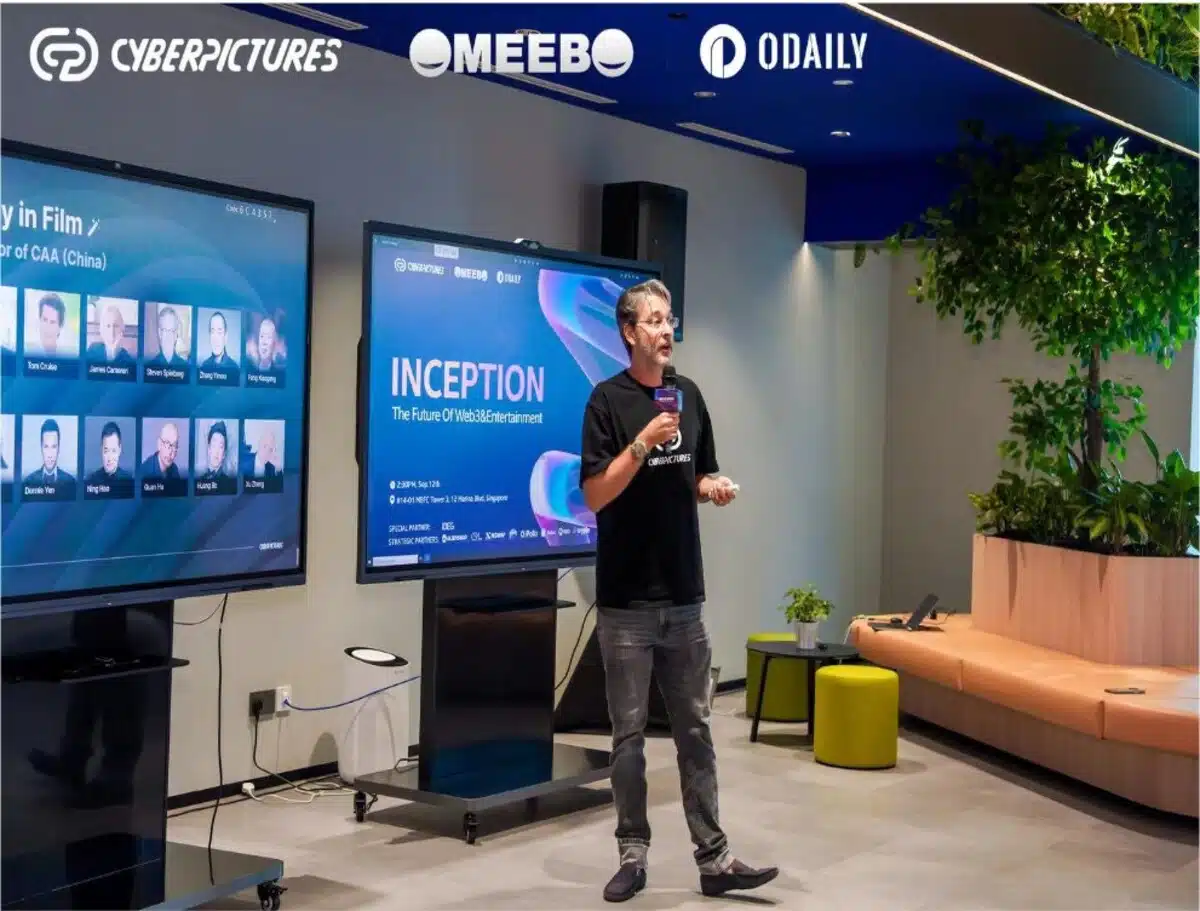
Since its inception, the motion picture industry has allowed studios and HNWIs (high-net-worth individuals)to make and often lose fortunes. However, ordinary individuals have rarely had access to film investments. And CyberPictures is working to change that.
CyberPictures gives everyone, even fans, the opportunity to be involved in a film, encompassing everything from creative to financial participation, breaking down an institutional forcefield that formerly kept them out.
The CyberPictures team is comprised of seasoned experts from Hollywood and China, with extensive experience in high-profile film and television productions. They also have technical and operational skill that is well ingrained in Web3, allowing them to provide a one-stop RWA (Real World Assets) solution for film productions and teams.
CyberPictures seeks to draw a larger population of Web2 users to the Web3 world through excellent content and fan economics as the platform focuses on entertainment-related RWA assets.
INCEPTION – The Future Of Web3 & Entertainment
CyberPictures and Odaily co-hosted the offline event “INCEPTION – The Future Of Web3 & Entertainment” at Token 2049 in Singapore on September 12th.
At the ceremony, Jonah Greenberg, the president of CyberPictures, and Yang presented speeches and announced the formal launch of the CyberPictures platform, as well as the platform’s first RWA project, Omeebo.
Greenberg, a veteran talent agency and producer engaged in the conventional film industry noted that, despite today’s huge box office earnings, the worldwide film industry still confronts structural issues. These include lower production output and tightened budgets as a result of the expansion of social media, streaming, and gaming, all of which have led to industrywide disasters, such as strikes and layoffs.
Speaking at the event in Singapore, Greenberg reminisced about a film he had produced in the city 20 years ago, lamenting a bygone era for the film industry. One Last Dance (dir. Max Makowski), starring Francis Ng and Harvey Keitel, was an homage to the classic triad films of Hong Kong and was made “by people who loved movies for people who loved movies.”
“In those days there was a broad system of sales agents and distributors that made indie filmmaking almost a piece of cake,” said Greenberg.
“Nowadays, getting a film made is far more challenging and the net result of this new world order is that fewer original films are getting made, forming a vicious cycle in which audiences lose their taste for originality,” he explained.
In the subsequent roundtable discussion, industry experts such as ArkStream Capital Co-Founder Allen Su, dForce Founder Mindao Yang, DigiFT Lead of Research and Innovation Ryan Chen, Republic Crypto Advisory Partner Jonathan Han, and PSE Trading Founder Xiaochen Wang delved deep into the opportunities and risks facing the hot RWA track in today’s market.
The speakers highlighted that the current hotspots in RWA are mostly focused on specific areas such as “tokenized government bonds,” but there is excitement about extending into a larger variety of industries. In addition to traditional assets, unconventional assets such as the entertainment sector, including cinema and television, have a distinct attraction for regular people.
They will continue to closely monitor CyberPictures’ future commercial developments and look forward to CyberPictures not only revolutionizing the traditional film industry but also opening up new possibilities for incremental traffic in the Web3 narrative and application area.
Furthermore, in an interview with Jonah Greenberg, the president of CyberPictures, at the event, we discussed what CyberPictures can do for the film and entertainment industry with the help of RWA, and how they bring new users to Web3:
1. Please briefly introduce CyberPictures, its vision, and its goals.
CyberPictures’ vision is to connect filmmakers and audiences through blockchain technology. Its goal is to package various rights into Real World Assets (RWA) through assessments at different stages of content creation, allowing users to directly participate in the creative process while assisting creators in fundraising and community building.
2. How does RWA change traditional asset management and investment, especially in the film and television industry?
From an asset management perspective, RWA’s biggest advantage is its permissionless nature, allowing people from around the world to easily allocate assets. In the context of the film and television industry, this feature enables users from different regions to easily participate in content creation.
3. Why did CyberPictures choose to combine RWA with the film and television industry, and what experiences in the film and television sector or insights into the Web3 industry suggest this is a highly promising trend?
The primary reason is that the traditional film and television industry has become increasingly centralized. Under the traditional corporate structure, decisions regarding whether to greenlight a film, allocate resources, and other considerations are driven more by corporate governance, risk assessment, censorship, and stock price concerns, rather than the interests of filmmakers and the quality of content. Leveraging blockchain technology to issue RWAs can shorten the path to content creation and bring it closer to the audience.
4. Can you share some examples of how CyberPictures combines RWA with film and television projects?
“Omeebo” is a new film and television IP created by Hollywood-level visual effects writer Philip Gelatt (“Love, Death & Robots”) and director Patrick Jean (“Pixels”). It combines cyber-virtual and real-world elements and issues different levels of NFTs—Silver, Gold, Platinum, and Diamond cards. Users holding these NFTs can participate in various aspects of film script creation, distribution, and merchandise production, ranging from 0 to 1.
5. How does CyberPictures use RWA to help filmmakers raise funds and manage project assets?
We first assess and rate projects at different stages and package assets based on the needs of creators and the rights that can be opened up. We then issue RWA assets. This process involves three main stages: for very early-stage projects, we conduct an Initial Film Offering (IFO) to provide seed funding to creators.
For mid-to-late-stage projects, we follow more compliant Security Token Offerings (STO) with regulated fund flow mechanisms. For IPs already in the market, we also experiment with NFT communities to explore community potential.
6. What opportunities and challenges does combining RWA with film projects present for investors?
For investors, the biggest opportunity is having a channel to invest in film assets that were previously inaccessible. The challenge lies in risk management because different investors have varying risk tolerance levels, which is why we conduct different project ratings.
7. How do RWA and blockchain address issues of piracy and copyright in the film and television industry?
Regarding copyright, after packaging assets, the biggest benefit is that ownership is now transparent and verifiable on the blockchain. This is a significant advancement for the industry, reducing friction in copyright-related commercial activities.
As for piracy, honestly, RWA doesn’t directly solve this problem. Technically, we can only address rights enforcement. Piracy is an industry-wide issue that requires broader solutions as the industry evolves.
8. Does blockchain or RWA help improve profit-sharing and contract management in film projects?
Certainly, profit-sharing and contract management become more transparent. In traditional copyright operations, many intermediary service providers incur costs, but the revenue distribution and ratios are often opaque. Many film investors only see book returns without realizing actual income. RWA can greatly address this issue.
9. How do you see RWA and blockchain impacting the long-term sustainability of the film and television industry?
The film and television industry has always found new business models and audiences through the iteration of new technologies and media. Just as internet technologies gave rise to Netflix, the maturity of blockchain technology could lead to new platforms that directly connect creators and audiences.
10. Can blockchain or RWA change the negotiation and payment methods between producers, directors, and actors?
It will become more flexible because the negotiation parties will now include the audience. This may lead to new and previously unimagined commercial exit models.
11. How do you ensure the scalability of RWA to meet the needs of film projects? Is protocol standardization or application layer more aligned with the needs of film projects?
The film industry has been pursuing standardization and industrialization from project inception to completion and audience reception. However, having a single protocol to address all project needs is challenging, especially for early-stage projects where creators have diverse ideas. From the perspective of the CyberPictures platform, we currently prefer to operate on a case-by-case basis.
12. How does CyberPictures use RWA to enhance audience engagement and interactivity, especially in content creation for film projects?
Using our first project, Omeebo, as an example, when users hold specific RWA assets, we offer benefits such as naming film characters, participating in script discussions, and even acting roles. We maintain constant communication with creators on how to better involve the community in content creation.
Other Features Offered
Greenberg gives a clear insight into how the platform strives to be an industry leader by emphasizing the importance of RWA assets in the film industry. Here is an in-depth description of the RWA features offered by the platform that make it stand out from the competition.
Providing High-Quality RWA Assets
CyberPictures has created a “Web3+Film” paradigm to bridge the gap between traditional film resources and the Web3 world. While solving the shortcomings of traditional film funding, it also provides new revenue streams for the Web3 industry.
CyberPictures Labs, a CyberPictures subsidiary, is in charge of choosing and developing high-quality entertainment-related RWA assets before releasing them through the CyberPictures Launchpad. Let us use an example to show how CyberPictures works.
Suppose a filmmaker or film company wants to make a cinematic adaptation of a successful online book. Following project clearance, they might seek a partnership with CyberPictures. After screening and selection, projects that match the criteria can utilize the CyberPictures Launchpad to issue NFTs, IFOs, or STOs (Security Token Offerings) to regular people or strategic partners with compliance licenses.
Holders of these tokens receive appropriate perks, such as revenue sharing based on the ultimate revenues of the film. Additionally, token holders may be granted additional benefits during the film production, promotion, and post-production stages.
Types of film-related RWA assets offered
- IFO (Initial Film Offering): For early or mid-stage projects with higher risk levels, these projects may be in the concept stage or just forming a team. However, if the film receives positive market feedback, the investment return can be substantial, similar to angel or seed funding in venture capital.
- STO (Security Token Offering): For mid to late-stage film investments, where the film is near or in production or post-production, akin to Series A or B funding in venture capital. CyberPictures collaborates with Republic, a technology company specializing in financial digitization, to provide STO-related services.
- NFT: Targeting late-stage projects focused on fan engagement, where the film is in the promotion stage or has already been released. NFTs can be issued, granting various content consumption rights. In this regard, CyberPictures also attracts a broader audience of Web2 users to the Web3 world through quality content and fan economics.
The Final Word
CyberPictures distinguishes itself from the competition by providing a full “Film + Web3” solution in which NFTs are only a tool and not the end goal. The main goal is to increase the number of high-quality incremental items and users on Web3.
It may inspire the development of more high-quality entertainment material and promote fan-driven economics by actively integrating users into the whole filmmaking process. Thus CyberPictures’ one-of-a-kind contribution to this arena is the integration of blockchain technology with traditional real-world assets.
To more about the platform, visit their official website.
Disclaimer: This is a paid post and should not be treated as news/advice.

